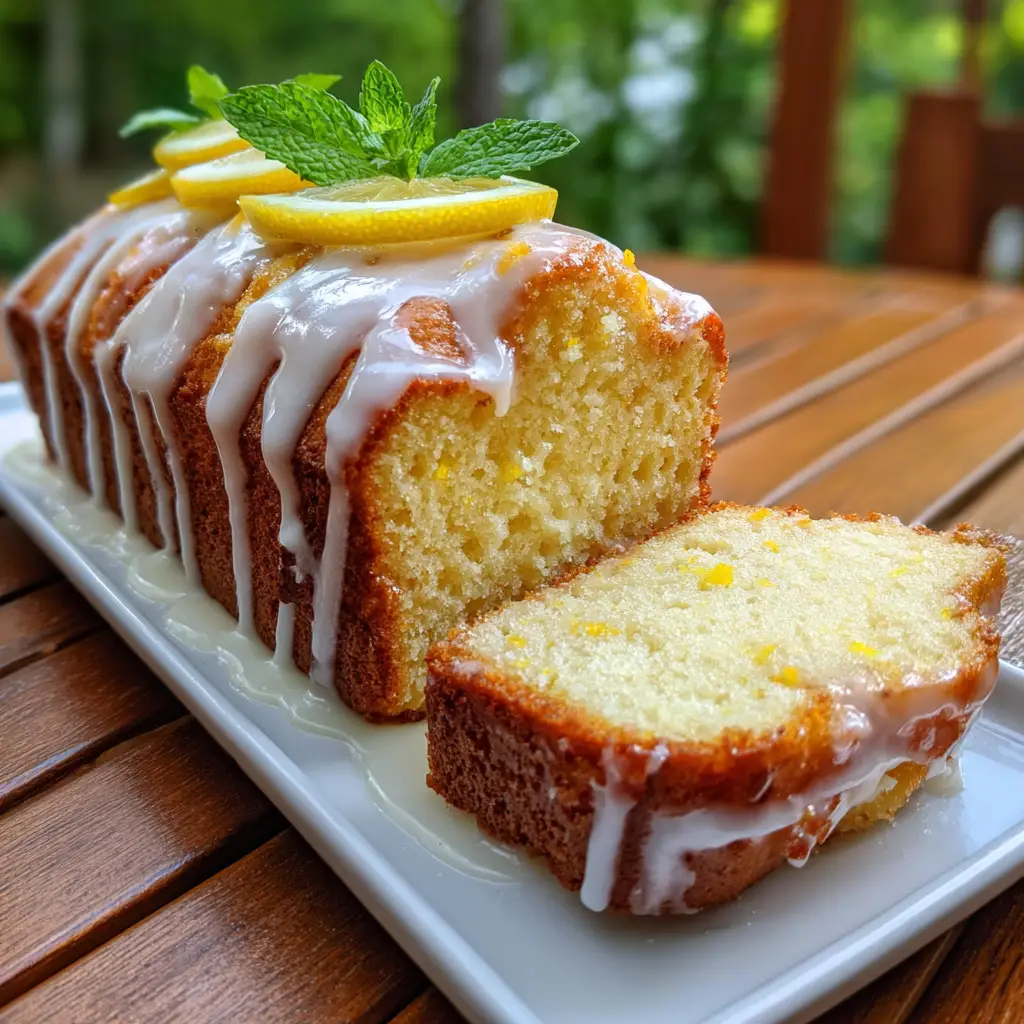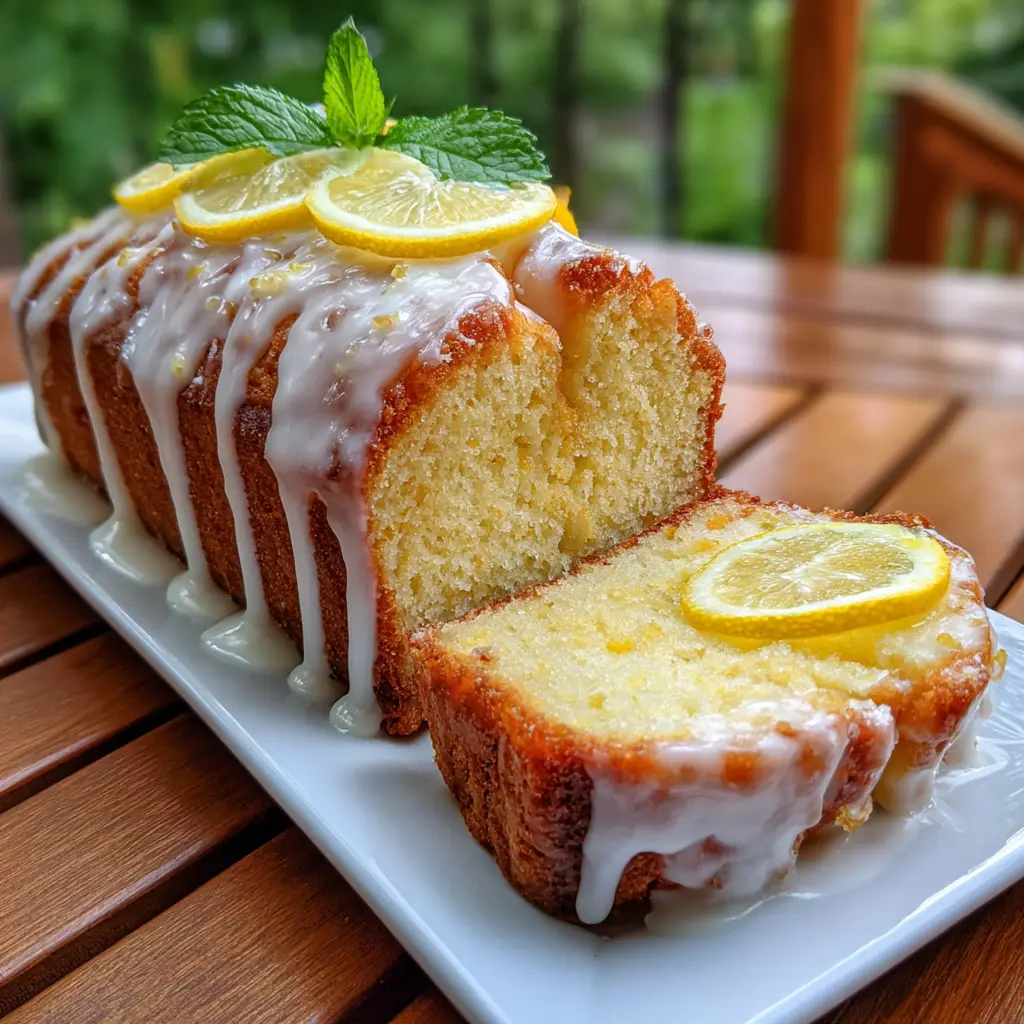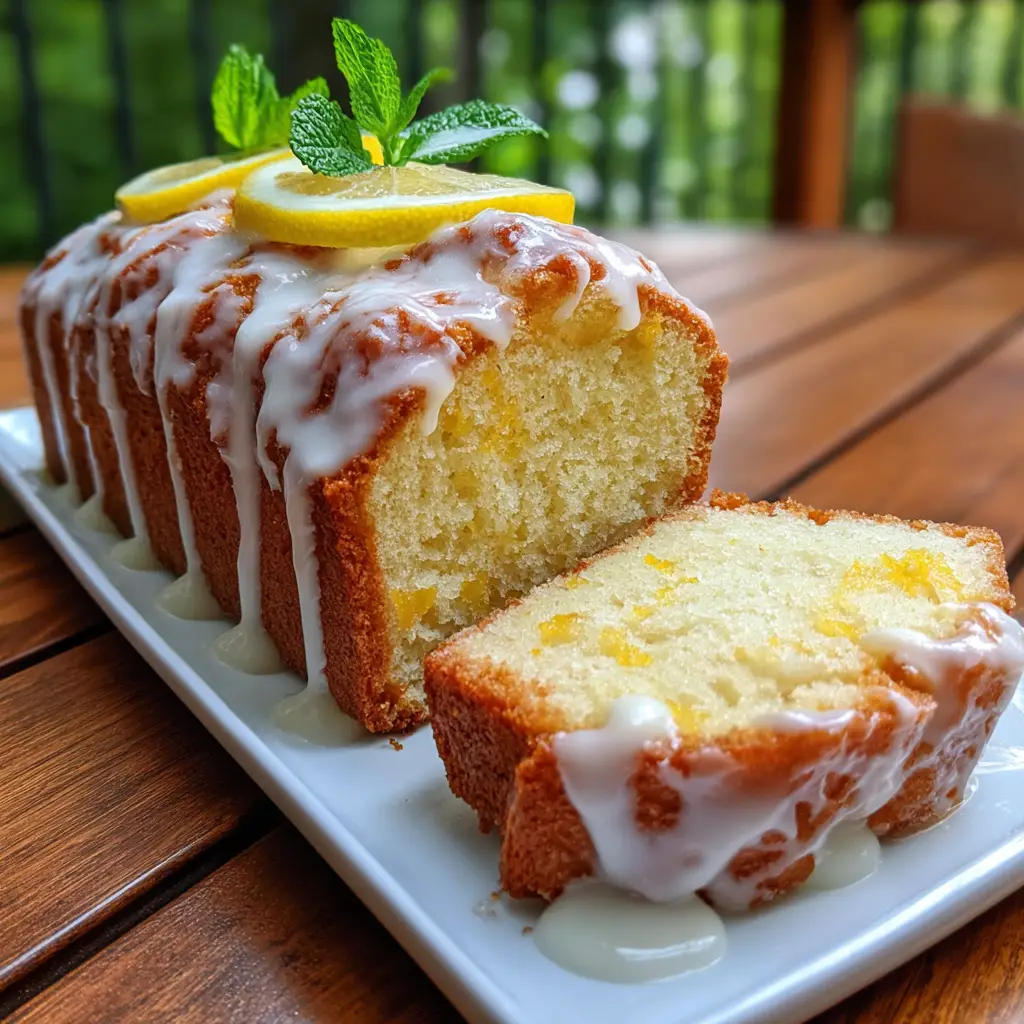Introduction to Lemon Pound Cake with Lemon Glaze
In the world of classic desserts, few treats are as universally beloved and deeply comforting as a perfect pound cake. But when you infuse that timeless, buttery foundation with the bright, sunny, and invigorating essence of lemon, you elevate it from a simple comfort food to a culinary masterpiece. The Lemon Pound Cake with Lemon Glaze is a symphony of balance and texture, a dense, velvety, and intensely moist crumb that is simultaneously rich and refreshing. Imagine a cake with a tight, tender grain, a crust that offers a delicate resistance before giving way to a burst of vibrant citrus flavor, all enveloped in a sleek, tart, and sweet glaze that crackles delicately with each bite.
Why Is This Lemon Pound Cake with Lemon Glaze So Popular?
The enduring and widespread popularity of Lemon Pound Cake is a phenomenon built on a foundation of perfect flavor balance, foolproof satisfaction, and timeless, comforting elegance. It is a dessert that feels both familiar and exciting with every single bite.
First and foremost is its unbeatable balance of flavors. The human palate is naturally drawn to the combination of rich, sweet fat and bright, acidic fruit. This cake delivers that in spades. The profound richness of the butter, eggs, and sour cream in the cake provides a luxurious, savory base that makes the sharp, clean, and aromatic punch of the lemon zest and juice truly sing. The glaze then doubles down on this citrusy vibrancy, creating a one-two punch of lemon flavor that is bold yet never harsh or cloying.
Secondly, its incredible, versatile texture is a major draw. A well-made pound cake is a textural marvel. It is dense, as a proper pound cake should be, yet it remains ethereally moist and tender, never dry or crumbly. The fine, tight crumb melts on the tongue, while the slightly crisp exterior and the thin, crackly layer of glaze provide a delightful contrast. This substantial yet soft texture makes it the perfect vehicle for a cup of coffee, tea, or a glass of cold milk.
Finally, its nostalgic power and elegant simplicity make it a perpetual favorite. Pound cake is a foundational recipe, often one of the first cakes a home baker learns to make. It evokes memories of grandmothers’ kitchens and family gatherings. The addition of lemon gives it a sophisticated twist, making it feel special and celebratory without requiring any complex techniques or hard-to-find ingredients. It is a dessert that is humble in its origins yet grand in its execution.
Why You’ll Love This Lemon Pound Cake with Lemon Glaze:
- The Perfect Balance of Rich and Bright: You will be captivated by the harmonious dance between the rich, buttery cake and the vibrant, zesty lemon glaze.
- Unbelievably Moist and Tender: You will love the velvety, dense crumb that stays incredibly moist for days, thanks to the addition of sour cream.
- A Study in Simple Elegance: This cake is stunning in its simplicity, requiring no fancy decoration to impress and delight everyone who tries it.
- Versatile for Any Occasion: You will appreciate how this cake seamlessly fits into breakfast, brunch, an afternoon snack, or a dessert course.
- Excellent for Make-Ahead Meals: This cake’s flavor actually improves after a day, making it a perfect do-ahead dessert for stress-free entertaining.
Here’s what you’ll need:
The success of this recipe hinges on the quality of its ingredients and the method of combining them. Using fresh lemons is absolutely non-negotiable.
For the Lemon Pound Cake:
- 3 cups (375g) All-Purpose Flour, spooned and leveled
- ½ teaspoon Baking Soda
- ½ teaspoon Baking Powder
- 1 teaspoon Salt
- 1 cup (2 sticks or 226g) Unsalted Butter, at room temperature
- 2 ½ cups (500g) Granulated Sugar
- 6 large Eggs, at room temperature
- 1 cup (240g) Full-Fat Sour Cream, at room temperature
- Zest of 3 large Lemons (approximately 2 tablespoons)
- ¼ cup (60ml) Fresh Lemon Juice (from about 1-2 lemons)
- 2 teaspoons Pure Vanilla Extract
For the Lemon Glaze:
- 2 cups (240g) Powdered Sugar, sifted
- 3-4 tablespoons Fresh Lemon Juice
- 1 tablespoon Light Corn Syrup (optional, for a super shiny, crackly glaze)
- Zest of 1 Lemon (for garnish)

How to Make Lemon Pound Cake with Lemon Glaze:
Now that you have your ingredients ready, let’s dive into the steps for making this delightful Lemon Pound Cake with Lemon Glaze. It’s as easy as pie, and I promise you’ll feel like a culinary superstar!
Step 1: Prepare the Pan and Preheat the Oven
Preheat your oven to 325°F (165°C). This lower temperature is key for baking a large pound cake evenly without over-browning the exterior. Thoroughly grease and flour a 10-cup Bundt pan or two 9×5-inch loaf pans. Ensure you get into every crevice to guarantee a clean release.
Step 2: Combine the Dry Ingredients
In a medium bowl, whisk together the 3 cups of flour, ½ teaspoon of baking soda, ½ teaspoon of baking powder, and 1 teaspoon of salt. Whisk for at least 30 seconds to ensure the leavening agents and salt are perfectly distributed. This guarantees a consistent rise and flavor.
Step 3: Cream the Butter and Sugar
In the bowl of a stand mixer fitted with the paddle attachment (or using a hand mixer), beat the room-temperature butter on medium speed until it is smooth and creamy, about 1 minute. Gradually add the 2 ½ cups of granulated sugar with the mixer running. Increase the speed to medium-high and beat for a full 4-5 minutes, until the mixture is extremely pale, fluffy, and almost white in color. This step is crucial for aerating the batter and creating the cake’s fine texture.
Step 4: Incorporate the Eggs and Flavorings
Reduce the mixer speed to medium. Add the 6 room-temperature eggs, one at a time, beating until each egg is fully incorporated before adding the next. Scrape down the bowl and beater thoroughly after the third egg. The mixture may look slightly curdled at this point; this is normal. Beat in the lemon zest, ¼ cup of lemon juice, and vanilla extract.
Step 5: Combine Wet and Dry Ingredients
Reduce the mixer speed to low. Add the dry ingredients to the wet ingredients in three parts, alternating with the room-temperature sour cream in two parts, beginning and ending with the dry ingredients. Mix only until just combined after each addition. Do not overmix! A few streaks of flour are okay.
Step 6: Bake to Golden Perfection
Spoon the thick batter into the prepared pan(s) and smooth the top. Tap the pan firmly on the counter a few times to release any large air bubbles. Bake for 60-80 minutes (less for loaf pans, more for a Bundt) or until a long wooden skewer inserted into the center of the cake comes out clean with just a few moist crumbs attached. The top should be a deep golden brown and spring back when lightly touched.
Step 7: Cool and Glaze
Let the cake cool in the pan on a wire rack for 25-30 minutes. Then, carefully invert it onto the rack to cool completely. The cake must be completely cool before glazing. To make the glaze, whisk the sifted powdered sugar, 3 tablespoons of lemon juice, and the optional corn syrup together until smooth. It should be thick but pourable. Add the final tablespoon of lemon juice if needed. Drizzle the glaze over the cooled cake and immediately sprinkle with the additional lemon zest for garnish.
Tips for Success:
- Room Temperature Ingredients are Critical: This is the golden rule of pound cake. Cold ingredients will not emulsify properly, leading to a dense, heavy cake.
- Cream the Butter and Sugar Thoroughly: This is the primary source of leavening. A pale, fluffy mixture is your goal.
- Do Not Overmix After Adding Flour: Overmixing develops gluten, which leads to a tough, rubbery cake. Mix on low and only until the ingredients are combined.
- Use Fresh Lemons: Bottled lemon juice lacks the bright, complex flavor of freshly squeezed. The zest contains the potent citrus oils and is essential for a powerful lemon aroma.
- Cool Completely Before Glazing: Glazing a warm cake will cause the glaze to melt, become transparent, and soak into the cake rather than forming a beautiful, opaque shell.

Equipment Needed:
- Stand Mixer or Hand Mixer
- 10-cup Bundt Pan or two 9×5-inch Loaf Pans
- Mixing Bowls
- Whisk
- Zester (Microplane)
- Juicer
- Fine-Mesh Sieve (for sifting powdered sugar)
- Wooden Skewer or Cake Tester
- Wire Cooling Rack
Variations of Lemon Pound Cake with Lemon Glaze:
- Lemon Blueberry: Gently fold 1 ½ cups of fresh or frozen (do not thaw) blueberries, tossed in 1 tablespoon of flour, into the batter at the end.
- Lemon Poppy Seed: Add ¼ cup of poppy seeds to the dry ingredients.
- Lemon Lavender: Add 1 teaspoon of culinary dried lavender to the dry ingredients for a floral, sophisticated twist.
- Cream Cheese Swirl: Beat 8 oz of softened cream cheese with ¼ cup sugar and 1 egg, then swirl it into the batter before baking.
- Gluten-Free: Substitute the all-purpose flour with a 1:1 gluten-free baking blend.
Serving Suggestions for Lemon Pound Cake with Lemon Glaze:
- With Fresh Berries and Whipped Cream: Serve a slice with a handful of macerated strawberries, raspberries, and a dollop of freshly whipped cream.
- As a Trifle Component: Cube the cake and layer it with lemon curd, blueberries, and whipped cream for a stunning dessert.
- Toasted for Breakfast: A lightly toasted slice with a pat of butter is a sublime way to start the day.
- With a Cup of Tea or Coffee: Its classic simplicity makes it the perfect companion for your favorite hot beverage.
Prep Time:
20 minutes
Cooking Time:
70 minutes
Total Time:
1 hour 30 minutes (plus cooling time)
Nutritional Information (Approximate per slice, recipe makes 16):
- Calories: ~450 kcal
- Protein: 5 g
- Sodium: 220 mg
- Sugar: 50 g
- Fat: 18 g (Saturated: 11 g)
- Carbohydrates: 70 g
- Fiber: 1 g
Please note: This is an estimate and can vary significantly based on the specific brands of ingredients you use and the slice size.
FAQs about Lemon Pound Cake with Lemon Glaze:
Q: Why did my pound cake sink in the middle?
A: The most common causes are underbaking, opening the oven door too early, or an issue with leavening (old baking soda/powder). Ensure your cake is fully tested with a skewer and your oven temperature is accurate.
Q: My cake is dry. What happened?
A: Dryness is usually a result of overbaking or overmixing the batter after the flour was added. Using a kitchen scale to measure flour is the best way to avoid accidentally using too much.
Q: Can I use yogurt instead of sour cream?
A: Yes, plain full-fat Greek yogurt can be used as a 1:1 substitute for sour cream with excellent results.
Q: How should I store this cake?
A: Once the glaze is set, cover the cake tightly with plastic wrap or store it in an airtight container at room temperature for up to 3 days. It can also be refrigerated for up to 5 days.
Q: Can I freeze Lemon Pound Cake?
A: Absolutely! Wrap the unglazed, cooled cake tightly in plastic wrap and then in foil. Freeze for up to 3 months. Thaw overnight at room temperature and glaze before serving.
Final Thoughts:
The Lemon Pound Cake with Lemon Glaze is more than a recipe; it is a benchmark of baking prowess and a timeless expression of flavor. It is a cake that rewards patience and precision with a result that is both humble and spectacular. The process of creaming the butter and sugar, the zesting of fresh lemons, and the final drizzle of the glossy glaze are all parts of a rewarding culinary ritual. This cake has the power to brighten a gloomy day, to celebrate a special moment, or to simply provide a moment of pure, unadulterated pleasure with a cup of tea. So, zest your lemons, bring your ingredients to room temperature, and get ready to create a new, sunshiny classic that will earn a permanent spot in your baking repertoire.




